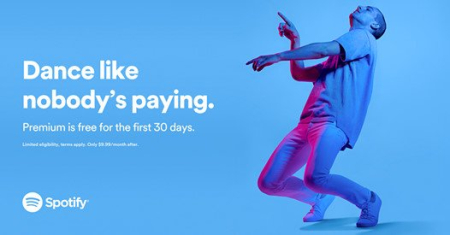Spotify’s new ad campaign ‘Dance Like Nobody’s Paying‘ drew ire from musicians and artist advocates “Dance like nobody’s paying because we aren’t,” tweeted singer/songwriter David Poe in response. The ad is also an ironic reminder of the need to shift to user-centric royalties, writes Chris Castle.
____________________________
By Chris Castle of Music Tech Solutions
I used to laugh off Spotify’s never ending stream of public messaging disasters- if screwups were Easter eggs, Daniel Ek would be the Easter Bunny hopping from one to another to make sure he scooped them all into his basket. But the stark double entendre of Spotify’s latest campaign is the end of funny. Hopefully it’s one more step on the road to user-centric royalties.
As reported in Hypebot, Spotify’s latest attempt to commoditize the value of music got artists and fans up in arms.

This message is obviously offensive (but the underlying business practice is no doubt permitted under Spotify’s major label licenses–which raises a whole other question of how much longer does a publicly traded venture-backed money-losing company with a $25 billion market cap deserve to get special royalty free deals).
Here’s @Spotify’s new tone-deaf ad campaign. Keep in mind that it takes 380,000 streams a month on @Spotify for an artist to earn minimum wage. Meanwhile, the average @Spotify employee earns $14,000 a month. Nobody’s paying? We musicians are, with our lives. #IRespectMusic pic.twitter.com/mroqQNGxLJ
— Blake Morgan (@TheBlakeMorgan) July 9, 2019
So Spotify is insulting, what else is new. Underneath that message is another subtext, though: Dance like nobody’s paying because nobody’s playing. Or said another way, the machines are playing. As Laura Kobylecky noted in a prescient post on MusicTechPolicy, the Spotify “fake artist” controversy has some ominous ancestry.
The tune had been haunting London for weeks past. It was one of countless similar songs published for the benefit of the proles by a sub-section of the Music Department.”
From 1984 by George Orwell
In the dystopian world of George Orwell’s 1984, there is a machine called a “versificator.” The versificator makes what might be called “fake” music—songs that are “composed without any human intervention whatever.” In April of 2016, “A New Rembrandt” was revealed (1). The painting, like the songs of a versificator, was made by machines. In August of 2016, Music Business Worldwide (2) accused Spotify of “creating fake artists.” What is a fake artist? Can music be fake?
The world of 1984 is a grim place. Members of the “Party” have access to resources based on their rank. The rest of society are called “Proles.” The term is short for the “proletarian” and refers to the working class. The Proles make up the majority of society, and so the Party provides them with various sources of entertainment to keep them from getting too restless.
The versificator is one of the entertaining distractions made by the Party. A versificator generates songs that are “composed without any human intervention whatever.” The results range from insipid love songs like “Hopeless Fancy,” to the “savage, barking rhythm” of the “Hate Song”—designed to stir rage against political enemies. The novel’s protagonist describes one of these songs as “dreadful rubbish.”
But the Proles like it fine. The song “Hopeless Fancy,” takes hold among them and “haunts” London for weeks. In this case, the art of the machine seems adequate for consumption.
So if you dance like nobody’s paying, realize that it’s entirely possible that nobody is paying because nobody’s playing, either. Spotify can use either the free trial or the fake artist to drive down the royalties the company pays out to flesh-and-blood artists, particularly the ones that lack the leverage to get one of the goodie packed deals with minimum guarantees, greater of formulas, per-subscriber minima and non recoupable technology payments or breakage. And then there’s the stock.
What would fix this is switching to user-centric royalties or what MTS readers will recall as the “ethical pool”. No freebies, every artist is paid for every stream and fans are not deceived into believing that their monthly subscription goes to the artists they listen to rather than the ones they don’t ever stream. If people could manage to look beyond this quarter’s results, the future is waiting.
How about “Dance like creators are paid fairly”? Now there’s a message–it has a nice beat and you can dance to it.
MORE: Spotify Draws Fire For ‘Tone Deaf’ Ad Campaign: ‘Dance As If No One Is Paying”